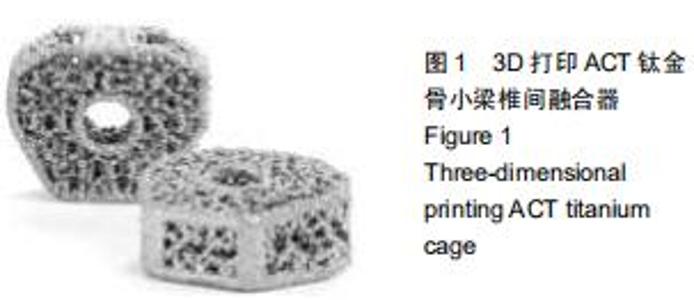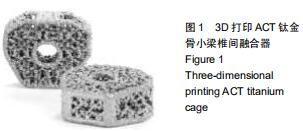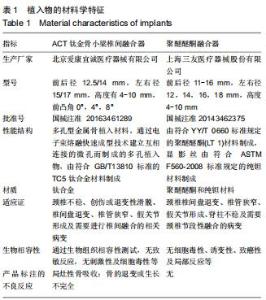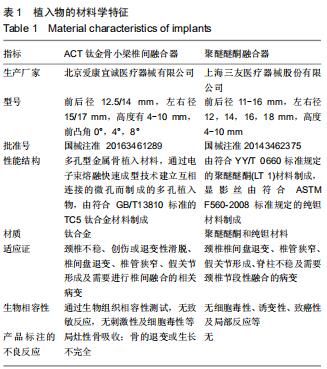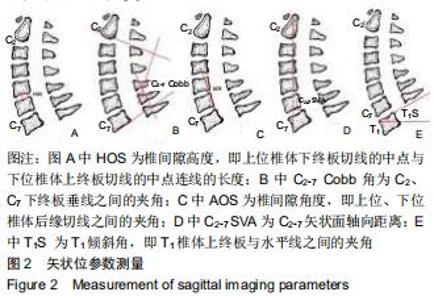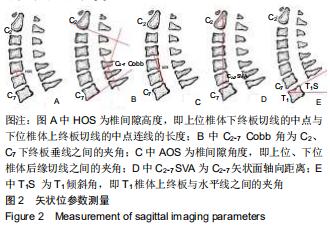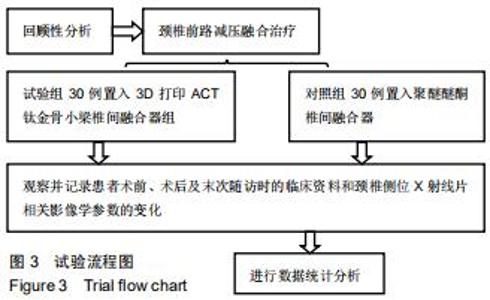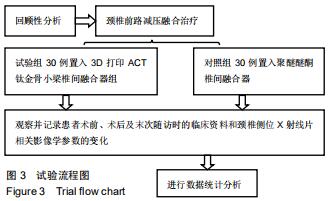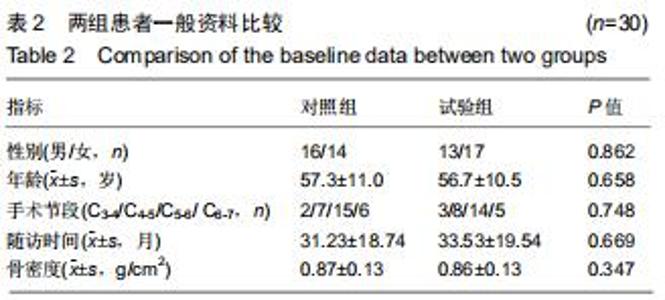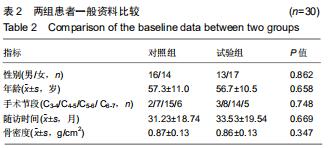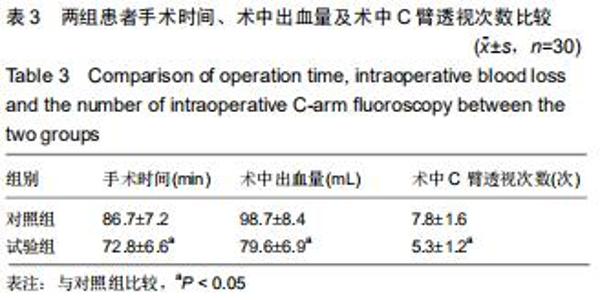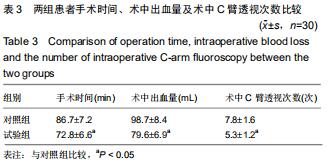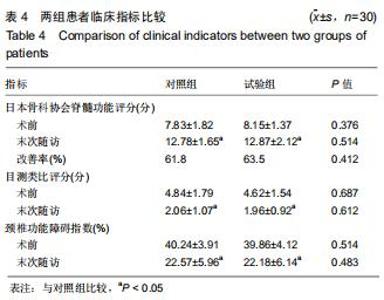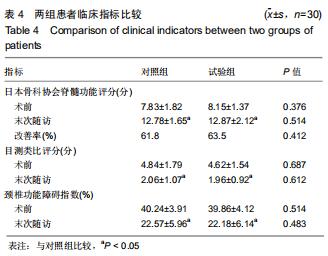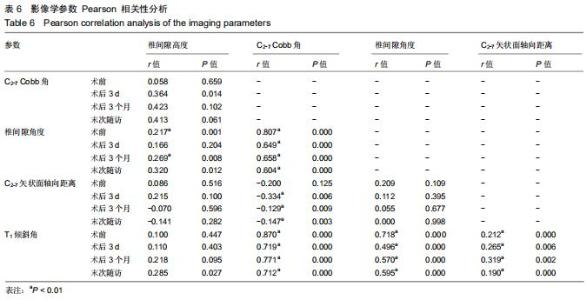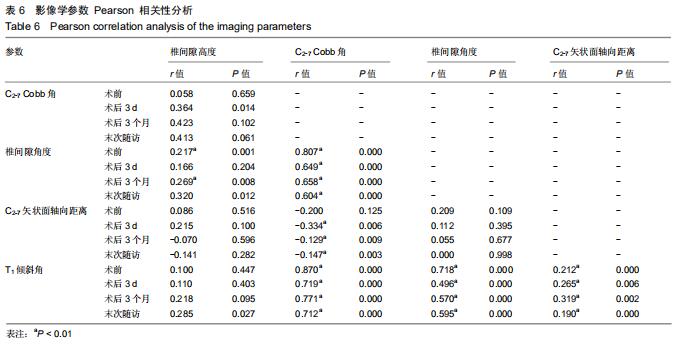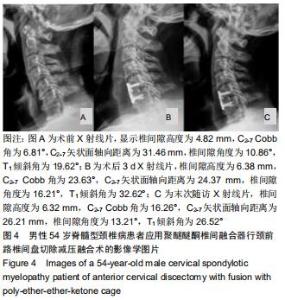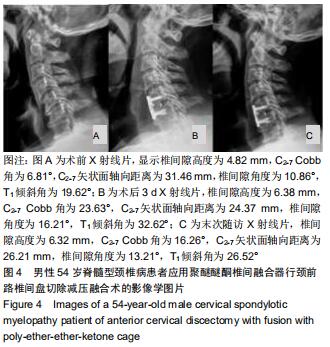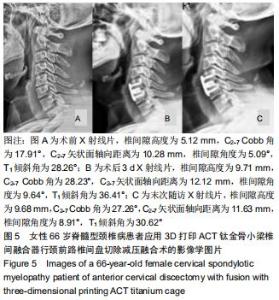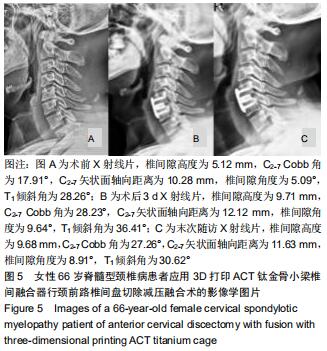Chinese Journal of Tissue Engineering Research ›› 2020, Vol. 24 ›› Issue (36): 5741-5748.doi: 10.3969/j.issn.2095-4344.2916
Changes in cervical sagittal balance after three-dimensional printing ACT titanium cage in anterior cervical discectomy with fusion
Yang Xu, Zhao Xiaofeng, Qi Detai, Wang Xiaonan, Jin Yuanzhang, Zhou Runtian, Zhao Bin
Department of Orthopedics, Second Hospital of Shanxi Medical University, Taiyuan 030001, Shanxi Province, China
-
Received:2020-01-18Revised:2020-01-20Accepted:2020-03-09Online:2020-12-28Published:2020-10-27 -
Contact:Zhao Bin, Chief physician, Professor, Master’s supervisor, Department of Orthopedics, Second Hospital of Shanxi Medical University, Taiyuan 030001, Shanxi Province, China -
About author:Yang Xu, Master candidate, Department of Orthopedics, Second Hospital of Shanxi Medical University, Taiyuan 030001, Shanxi Province, China
CLC Number:
Cite this article
Yang Xu, Zhao Xiaofeng, Qi Detai, Wang Xiaonan, Jin Yuanzhang, Zhou Runtian, Zhao Bin. Changes in cervical sagittal balance after three-dimensional printing ACT titanium cage in anterior cervical discectomy with fusion[J]. Chinese Journal of Tissue Engineering Research, 2020, 24(36): 5741-5748.
share this article
|
[1] MUZEVIĆ D, SPLAVSKI B, BOOP FA, et al. Anterior cervical discectomy with instrumented allograft fusion: lordosis restoration and comparison of functional outcomes among patients of different age groups. World Neurosurg. 2018;109: e233-e243.
[2] OLIVER JD, GONCALVES S, KEREZOUDIS P, et al. Comparison of outcomes for anterior cervical discectomy and fusion with and without anterior plate fixation: a systematic review and meta-analysis. Spine. 2018;43(7): E413-E422.
[3] 陈丹华,葛许锋,成红兵,等.颈椎桥型锁定融合器在颈椎前路减压融合术中的应用[J].实用临床医药杂志,2020,24(1):32-35.
[4] HAWS BE, KHECHEN B, NARAIN AS, et al. Iliac crest bone graft for minimally invasive transforaminal lumbar interbody fusion: a prospective analysis of inpatient pain, narcotics consumption, and costs. Spine (Phila Pa 1976).2018;43(18): 1307-1312.
[5] SCHMITZ P, NEUMANN CC, NEUMANN C, et al. Biomechanical analysis of iliac crest loading following cortico-cancellous bone harvesting. J Orthop Surg Res. 2018;13(1):108.
[6] LEE YS, KIM YB, PARK SW. Risk factors for postoperative subsidence of single-level anterior cervical discectomy and fusion: the significance of the preoperative cervical alignment. Spine. 2014;39(16):1280-1287.
[7] 程文俊,王俊文,焦竞, 等.3D打印钛合金骨小梁金属臼杯在初次全髋关节置换术应用的临床和影像学评估:5年临床随访[J].中华创伤骨科杂志,2018,20(12):1066-1071.
[8] PATWARDHAN AG, KHAYATZADEH S, HAVEY RM, et al. Cervical Sagittal Balance: A Biomechanical Perspective Can Help Clinical Practice. Eur Spine J. 2018; 27(Suppl1):25-38.
[9] 杨洋,黎庆初,朱召银,等. 双节段前路颈椎自锁式融合器融合术后矢状位影像学参数的变化[J].中国脊柱脊髓杂志,2016,26(2):116-123.
[10] 刘涛,邱水强,徐志刚,等.颈椎前路椎间盘切除减压不同融合节段对脊柱-骨盆矢状位平衡的影响[J].中国修复重建外科杂志,2019,33(3): 265-272.
[11] 许艺荠,张雪松,孙太存,等.新型Zero-P与cage钛板椎间融合器修复颈椎病:早期稳定性对比[J].中国组织工程研究,2016, 20(22): 3227-3234.
[12] 刘涛,李浩曦,黄宇峰,等.下颈椎前路减压融合术后颈椎矢状位平衡的变化[J].中国脊柱脊髓杂志,2018,28(6):496-502.
[13] FURLAN JC, CRAVEN BC. Psychometric analysis and critical appraisal of the original, revised, and modified versions of the Japanese Orthopaedic Association score in the assessment of patients with cervical spondylotic myelopathy. Neurosurg Focus. 2016;40(6): E6.
[14] BRIDGES KJ, SIMPSON LN, BULLIS CL, et al. Combined laminoplasty and posterior fusion for cervical spondylotic myelopathy treatment: A literature review. Asian Spine J. 2018; 12(3):446-458.
[15] KAUR M, SINGH K. Review on titanium and titanium based alloys as biomaterials for orthopaedic applications. Mater Sci Eng C Mater Biol Appl. 2019;102:844-862. [16] MCGILVRAY KC, EASLEY J, SEIM HB, et al. Bony Ingrowth Potential of 3D-printed Porous Titanium Alloy: A Direct Comparison of Interbody Cage Materials in an in Vivo Ovine Lumbar Fusion Model. Spine J. 2018;18(7):1250-1260.
[17] VAZ G, ROUSSOULY P, BERTHONNAUD E, et al. Sagittal morphology and equilibrium of pelvis and spine. Eur Spine J. 2002; 11(1):80-87.
[18] RAO H, HUANG Y, LAN Z, et al. Does Preoperative T1 Slope and Cervical Lordosis Mismatching Affect Surgical Outcomes After Laminoplasty in Patients with Cervical Spondylotic Myelopathy? World Neurosurg. 2019;130:e687-e693.
[19] YOU J, TANG X, GAO W, et al. Factors predicting adjacent segment disease after anterior cervical discectomy and fusion treating cervical spondylotic myelopathy: A retrospective study with 5-year follow-up. Medicine. 2018;97(43): e12893.
[20] LING FP, CHEVILLOTTE T, LEGLISE A, et al. Which parameters are relevant in sagittal balance analysis of the cervical spine? A literature review. Eur Spine J. 2018; 27 (Suppl 1):8-15.
[21] HUANG Y, LAN Z, XU W. Analysis of sagittal alignment parameters following anterior cervical hybrid decompression and fusion of multilevel cervical Spondylotic myelopathy. BMC Musculoskelet Disord. 2019;20(1):1.
[22] PAVEL B, PETR S. Factors affecting sagittal malalignment due to cage subsidence in standalone cage assisted anterior cervical fusion. Eur Spine J.2007;16(9): 1395-1400.
[23] TOMÉ-BERMEJO F, MORALES-VALENCIA JA, MORENO-PÉREZ J, et al. Degenerative cervical disc disease: long-term changes in sagittal alignment and their clinical implications after cervical interbody fusion cage subsidence: a prospective study with standalone lordotic tantalum cages. Clin Spine Surg. 2017;30(5):E648-E655.
[24] 李斌,夏卿,华永新,等.多孔钽金属的骨外科应用:关节置换假体及软骨重建支架[J].中国组织工程研究,2015,9(12):1943-1947.
[25] LEE SH, KIM KT, SEO EM, et al. The influence of thoracic inlet alignment on the craniocervical sagittal balance in asymptomatic adults. J Spinal Disord Tech. 2011;25(2): E41-47.
[26] 赵文奎,于淼,韦峰,等.无症状成人颈椎矢状位曲度分析及其与全脊柱矢状位参数的关系[J].中国脊柱脊髓杂志,2015,25(3):231-238.
[27] WEI W, LIAO S, SHI S, et al. Straightened cervical lordosis causes stress concentration:a finite element model study. Australas Phys Eng Sci Med. 2013;36(1):27-33.
[28] TANG JA, SCHEER JK, SMITH JS, et al. The impact of standing regional cervical sagittal alignment on outcomes in posterior cervical fusion surgery. Neurosurgery (Baltimore). 2012;71(3): 662-669.
[29] PATWARDHAN AG, KHAYATZADEH S, HAVEY RM, et al. Cervical sagittal balance: a biomechanical perspective can help clinical practice. Eur spine J,2018;27(Suppl 1):25-38.
[30] ZHANG Y, LIU H, YANG H, et al. Between sagittal balance and axial symptoms in patients with cervical spondylotic myelopathy treated with anterior cervical discectomy and fusion. J Invest Surg. 2020;33(5):404-411.
[31] 余文超,袁文,陈华江,等.脊髓型颈椎病颈前路手术对术后颈椎矢状位平衡参数的影响[J].中华骨科杂志, 2018,38(21):1285-1292.
[32] WENG C, WANG J, TUCHMAN A, et al. Influence of T1 Slope on the Cervical Sagittal Balance in Degenerative Cervical Spine: An Analysis Using Kinematic MRI. Spine. 2016;41(3): 185-190.
[33] LIU W, FAN J, BAI J, et al. Magnetic resonance imaging: A possible alternative to a standing lateral radiograph for evaluating cervical sagittal alignment in patients with cervical disc herniation? Medicine (Baltimore). 2017;96(39):e8194. [34] 缪健荣,周志平,田守进,等.传统钛板加Cage与ROI-C治疗颈椎病术后矢状位参数的变化[J].南京医科大学学报(自然科学版), 2018, 38(11):1572-1575. |
| [1] | . Changes in Lumbosacral Sagittal Plane Parameters of L5/S1 Disc Herniation [J]. Chinese Journal of Tissue Engineering Research, 2023, 27(在线): 1-6. |
| [2] | Zhong Yizheng, Huang Peizhen, Cai Qunbin, Zheng Liqin, He Xingpeng, Dong Hang. Microstructural indexes that determine the trabecular bone maximum stress of micro-finite element models [J]. Chinese Journal of Tissue Engineering Research, 2023, 27(9): 1313-1318. |
| [3] | Peng Zhixin, Yan Wengang, Wang Kun, Zhang Zhenjiang. Finite element analysis and structural optimization design of 3D printed forearm braces [J]. Chinese Journal of Tissue Engineering Research, 2023, 27(9): 1340-1345. |
| [4] | Wu Tianliang, Tao Xiuxia, Xu Hongguang. Influence of different bone mineral densities on cage subsidence after stand-alone oblique lateral interbody fusion: three-dimensional finite element analysis [J]. Chinese Journal of Tissue Engineering Research, 2023, 27(9): 1352-1358. |
| [5] | Wen Xinghua, Ding Huanwen, Cheng Kai, Yan Xiaonan, Peng Yuanhao, Wang Yuning, Liu Kang, Zhang Huiwu. Three-dimensional finite element model analysis of intramedullary nailing fixation design for large femoral defects in Beagle dogs [J]. Chinese Journal of Tissue Engineering Research, 2023, 27(9): 1371-1376. |
| [6] | He Yinhao, Li Xiaosheng, Chen Hongwen, Chen Tiezhu. 3D printed porous tantalum metal in the treatment of developmental dysplasia of the hip: current status and application prospect [J]. Chinese Journal of Tissue Engineering Research, 2023, 27(9): 1455-1461. |
| [7] | Dang Yi, Du Chengyan, Yao Honglin, Yuan Nenghua, Cao Jin, Xiong Shan, Zhang Dingmei, Wang Xin. Hormonal osteonecrosis and oxidative stress [J]. Chinese Journal of Tissue Engineering Research, 2023, 27(9): 1469-1476. |
| [8] | Wang Yanjin, Zhou Yingjie, Chai Xubin, Zhuo Hanjie. Meta-analysis of the efficacy and safety of 3D printed porous titanium alloy fusion cage in anterior cervical discectomy and fusion [J]. Chinese Journal of Tissue Engineering Research, 2023, 27(9): 1434-1440. |
| [9] | Jiang Xiaocheng, Shi Lu, Wang Yinbin, Li Qiujiang, Xi Chuangzhen, Ma Zefeng, Cai Lijun. Systematical evaluation of bone fusion rate after interbody fusion in patients with osteoporosis and lumbar degenerative disease treated with teriparatide [J]. Chinese Journal of Tissue Engineering Research, 2023, 27(9): 1427-1433. |
| [10] | Yang Zhishan, Tang Zhenglong. YAP/TAZ, a core factor of the Hippo signaling pathway, is involved in bone formation [J]. Chinese Journal of Tissue Engineering Research, 2023, 27(8): 1264-1271. |
| [11] | Nie Chenchen, Su Kaiqi, Gao Jing, Fan Yongfu, Ruan Xiaodi, Yuan Jie, Duan Zhaoyuan, Feng Xiaodong. The regulatory role of circular RNAs in cerebral ischemia-reperfusion injury [J]. Chinese Journal of Tissue Engineering Research, 2023, 27(8): 1286-1291. |
| [12] | Gao Yu, Han Jiahui, Ge Xin. Immunoinflammatory microenvironment after spinal cord ischemia-reperfusion injury [J]. Chinese Journal of Tissue Engineering Research, 2023, 27(8): 1300-1305. |
| [13] | Bai Yulong, Li Zhonghai, Zhao Yantao, Xia Cencan, Shi Lei. History, current situation and prospect of tissue banks in China [J]. Chinese Journal of Tissue Engineering Research, 2023, 27(8): 1306-1312. |
| [14] | Sun Jiajia, Zhu Haidi, Lu Yun, Zhang Kai. Comparison of bone metabolism markers between type 2 diabetes mellitus and non-type 2 diabetes mellitus patients with hip fracture [J]. Chinese Journal of Tissue Engineering Research, 2023, 27(8): 1156-1160. |
| [15] | Huang Linke, Wei Linhua, Jiang Jie, Liu Qian, Chen Weiwei. Effects of estrogen combined with treadmill exercise on bone mass and articular cartilage in ovariectomized mice [J]. Chinese Journal of Tissue Engineering Research, 2023, 27(8): 1166-1171. |
| Viewed | ||||||
|
Full text |
|
|||||
|
Abstract |
|
|||||
